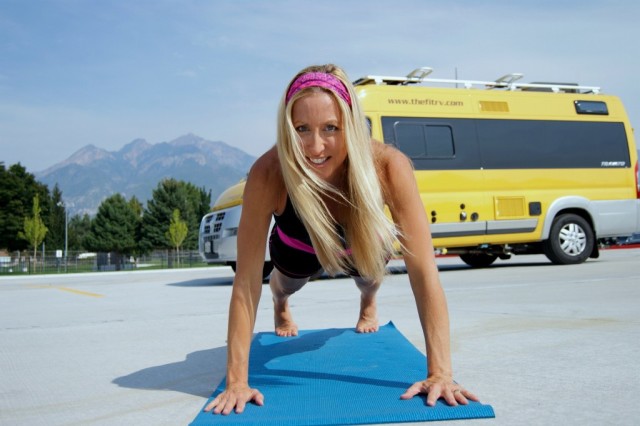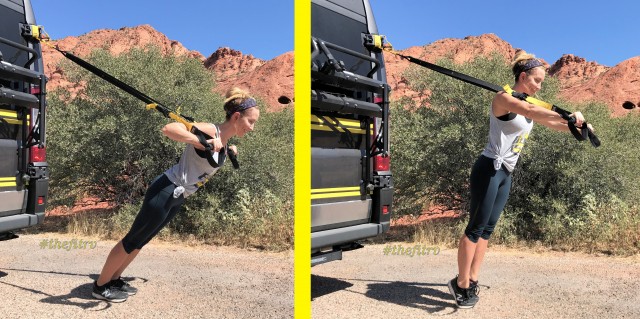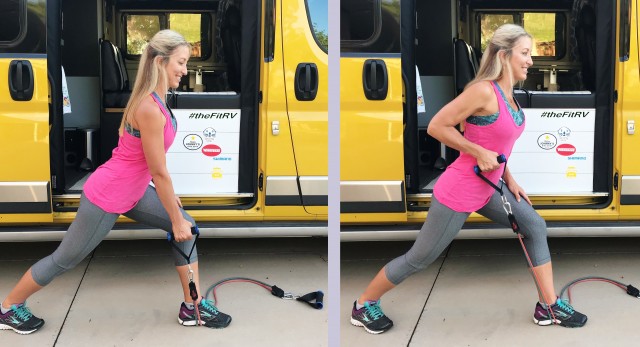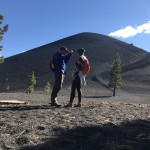This post may contain affiliate links.
A healthy fitness journey should be more than the pursuit of a buff-looking bod (… although admittedly, that’s a nice perk). More importantly, fitness should be a quest to strengthen our bodies so they can tackle anything our daily lives throw at them.

How many times have you heard someone with an injury report they got it in some weird and yet simple way… like a tweaked back from unloading the dishwasher or a trip on a rug? (I’ve heard both those examples just this past month.) That’s where “functional” strength training comes in. Functional fitness is all about training the basic movement patterns we do in our daily lives. Training functionally can ensure we move through life with efficient and capable bodies that are less prone to injury.
The Fab 5 Functional Movements:
There are 5 main movement patterns humans do on the regular (there are more, but we’re just talking the main ones here). If you want to be a strong, healthy, and awesome human yourself, you need to make sure you’re training each category ESPECIALLY as we’re aging. “Use it or lose it” is scary real, folks.
- Hip Dominant Movements
- Knee Bends
- Push
- Pull
- Locomotion
There are tons of exercises you can do for each movement category. And it can get more complicated as exercises can cross into multiple categories, too. But basically, when I’m training a client, the Fab 5 here are my default in designing workouts. For the most part, I design workouts based on MOVEMENT PATTERNS rather than on specific exercises. You can easily design your own workouts this way, too, and save a ton of cash from not needing your own trainer… (Except me… you still need me.)
Let’s Delve In, Shall We?
#1 Hip Dominant Movements:
How many times do you bend over in a day? A lot more than you probably even realize. Leaning over a counter to read something, bending to open a drawer, brushing your teeth over the sink… they all require bending from the hips, otherwise known as a “hip hinge”. The hinge is one of the most essential movement patterns we need to train, because it places demands on the lower back, making it vulnerable to injuries. Hinging not only requires lower back strength, it also requires glute and hamstring strength, as well as good range of motion through the hip joint itself. Many low back and hip-related injuries can be prevented. Hip hinge exercises, when done right, are one of the keys to doing just that.

Find this hip dominant move, “TRX Warrior 3”, over on my “TRX for Stability & Balance” workout plan!
There are other hip dominant movements, besides just the hinge, where the hip joint plays the primary role as well. It’s important to train using a variety of exercises to ensure your hips are strong and mobile and ready for whatever your day may throw at them.
Hip Dominant Exercise Suggestions:
- Bodyweight Hip Hinge
- Yoga Warrior 3
- Planked Pike-ups
- High Bench Step-ups
- Glute Bridges
- Kettlebell Swings
- Deadlifts
- Single Leg Deadlifts
Part two of this series goes deeper into this movement pattern. Click here for more hot tips on your hips! (Look at that! I’m a poet!)
#2 Knee Bend Movements:
While squatting is the main type of functional knee-bend we do in our daily lives, there are many other movements that require a knee bend… like climbing the stairs, lunging to reach something on the floor, lowering down to sit on the ground, etc. Knee bends require good range-of-motion to perform well, but also they require healthy low body strength.
As we age it is absolutely critical to train this category of movement regularly. Harsh truth: you simply cannot expect to age well without keeping up your leg strength, your knee stability, and your ankle joint mobility through regular exercise. Good news though, knee bend exercises are fun to do! (It’s my favorite category to work!!!)
Knee Bend Exercise Suggestions:
- Squats (feet narrow, traditional, wide)
- Lunges (forward, reverse, side, cross)
- Low-Box Step Ups
- Yoga Chair Pose
- Single-Leg Squats
- Split Squats
- Squat Walks
- Plié Squat
- Jump Squat
- Sled Pushes
Part 3 of this series goes deeper into this movement pattern. Click here for more squeeze on your knees! (Okay so maybe my poet days ended with the hips…)
#3 Push Movements:
Pushing exercises will strengthen your ability to, well, push! Pushing works your chest muscles and will hit your triceps and shoulders, too, depending on the exercise. This category can be broken down even further into vertical pushes (which work your shoulders more) and horizontal pushes (which work the triceps more).
Defining vertical and horizontal is in relation to your torso. So, that makes pushups a horizontal push whether doing wall-pushups, TRX pushups (like the picture above), or traditionally. You want to do a variety of vertical and horizontal pushing exercises since they hit your ‘push muscles’ differently.
Horizontal Push Exercise Suggestions:
- Pushups
- Planks
- Bench Press
- Flies
- Cable Single Arm Standing Chest Press
Vertical Push Exercise Suggestions:
- Dumbbell Standing Shoulder Press
- Resistance Bands Single Arm Shoulder Press
- TRX Rollouts
- Handstands
- Dumbbell Front or Lateral Raises
#4 Pull Movements:
Pull exercises have total body benefits, and most of us aren’t doing them enough. The big drawback is that you really do need some sort of equipment to perform them. This category is why James and I travel with both a TRX and a resistance bands kit. The other functional movement categories we can hit without equipment. Not this one.
Pulling movements strengthen many muscles in our back and beyond: our lats, serratus anterior (the area around your rib cage that helps stabilize your core), deltoids, traps, and erector spinae (muscles in your lower back), as well as our biceps and forearms. Other core muscles can get hit too, like your internal and external obliques. Besides all the targeted muscles, pulling exercises can improve your posture and overall muscular balance. Just like pushing, pull movements are divided into horizontal and vertical.
Horizontal Pull Exercise Suggestions
- Rowing
- Inverted Rows
- Single Arm Bent Row
- Seated Resistance Band Pull
- TRX Row
Vertical Pull Exercise Suggestions
- Pull-ups and Chin-ups
- Rope Climbs
- Lat Pulls
- Bent-Over Resistance Bands Lat Pulls
- TRX seated Lat Pulls
#5 Locomotion:
Locomotion, like walking, running, and moving through space… is the movement our bodies are most specifically designed to do, and yet it’s pretty commonly neglected when it comes to training programs. While it sounds quite simple to train (‘I’ll just go take a walk!’) it’s a lot more complex than that.

Breaking down locomotion from a physiological standpoint, it requires pelvic and core stability (which includes the lumbar spine) with extremities moving in opposition. It also requires some healthy rotation through the thoracic spine and hips. So while, sure, walking is the most basic and obvious way to train locomotion, there are many other beneficial exercises that will even further strengthen and improve stability, posture, rotation, and gait mechanics that go way beyond simply taking a walk.
Locomotion Exercise Suggestions:
- Walking/Running Hill and Speed Intervals
- Standing Opposite Knee to Elbow
- Bird-Dogs
- Dead-Bugs
- Side-Plank Thread the Needles
- Abs Bicycle Crunches
- Lunge-walks
- Sideways Squat-walking
- Farmers Carries
- Overhead Carries
- Tai Chi
- Skipping
- Bear Crawls
- Med Ball Wall Tosses
How To Build Your Own Functional Workout:
Choose one exercise that seems appropriate for your fitness and ability level out of each of the 5 functional movement pattern categories. Do 10-15 reps of each of the 5 chosen exercises. Repeat that a total of 3 times through. And as easy as that, you just acted as your own personal trainer and completed a functional fitness workout!
Final Thoughts…
One of the things I love about functional fitness is there’s a PURPOSE here. A reason to work out and a clear understanding of why we’re doing the exercises we’re doing. It allows exercise to make sense and that right there helps keep me motivated. May it do the same thing for you!
Comments and questions are welcomed below. As always you wonderful fitRVers you, I’m rooting for you!
xo, Trainer Stef
Ready to read on? Click here for Functional Fitness Part 2: all about your fabulous hips. 🙂














Great write-up, Stefany! I discovered this style of workout last year. Much more interesting than arranging workout by muscle type. More, please. Keep up the good work.
Glad you’re already a functional fitness enthusiast! Stay strong, Odin! xo
Love all your and James’ write ups! Looking forward to seeing you on the road! If all goes well I’ll be in my Travato in a couple of months! Keep those motivational posts coming as i need all the help i can get!
I’ll keep my fingers crossed you get your Travato very soon, Jeannie! As for fitness motivation, keep reading and educating yourself, it’s one of the best motivators there is! xo
Very nice write-up. My gym warm-up always includes *slow* side bends using 20# and 25# kettle or dumb bell’s. That one exercise does more good for my lower back than anything I have tried. I have yet to find a way to duplicate that on the road – resistance bands don’t work the same way as a weight pulling down.
What do you travel with in your van that’s heavy? Example, holding two water gallons would get you close to duplicating it. Even more challenging, do a side elbow plank with hip lifts! You won’t get the same stretch, but you’ll get a lot more strength and stability benefits than with the standing leans. 🙂